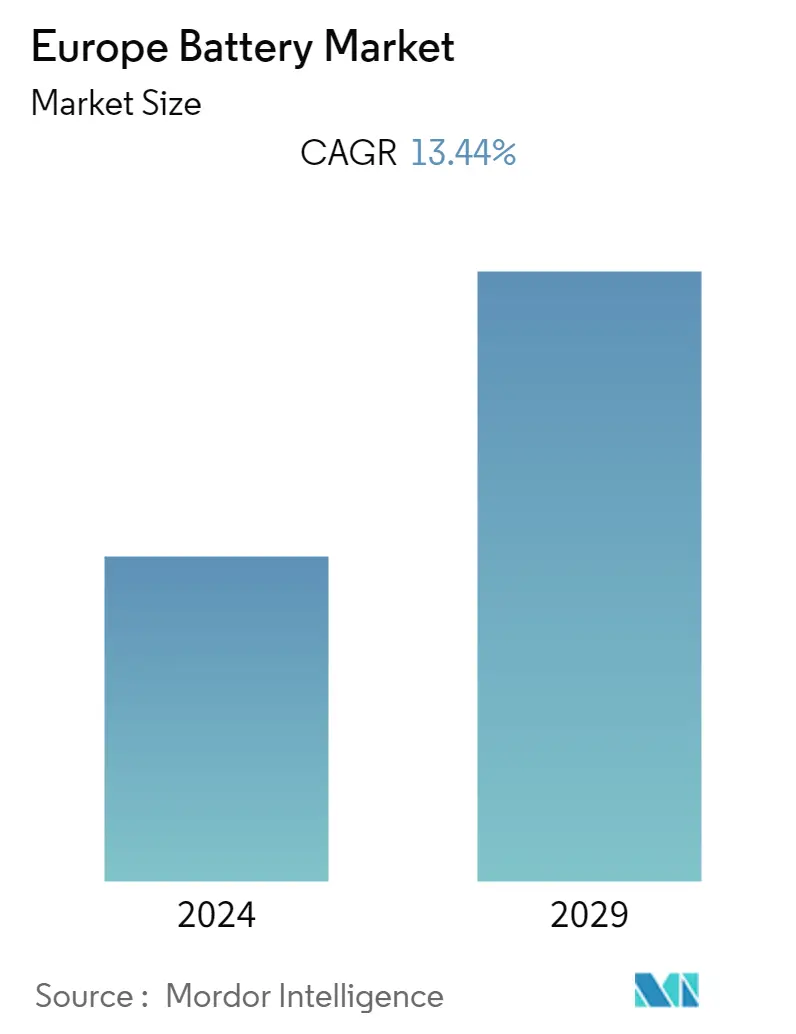Market Size of Europe Battery Industry

| Study Period | 2020 - 2029 |
| Base Year For Estimation | 2023 |
| Forecast Data Period | 2024 - 2029 |
| Historical Data Period | 2020 - 2022 |
| CAGR | 13.44 % |
| Market Concentration | Low |
Major Players
*Disclaimer: Major Players sorted in no particular order |
Europe Battery Market Analysis
Europe battery market is estimated to be at USD 23.34 billion by the end of this year and is projected to reach USD 43.84 billion in the next five years, registering a CAGR of 13.44% during the forecast period.
- Over the medium term, major factors driving the market include declining lithium-ion battery prices, rapid adoption of electric vehicles, growing renewable sector, and increased sale of consumer electronics.
- On the other hand, the demand-supply mismatch of raw materials will likely hinder market growth during the forecast period.
- Nevertheless, the increasing demand for the fast delivery of products pushed for improvements in the logistics and distribution business in the European region will likely provide ample opportunities for Li-ion batteries in the material handling industry in the coming years.
- Germany is expected to witness significant growth during the forecast years due to the increasing automotive industry during forecast period.
Europe Battery Industry Segmentation
A battery is a device that converts chemical energy contained within its active materials directly into electric energy by means of an electrochemical oxidation-reduction (redox) reaction.
European battery market is segmented by type, technology, application, and geography. By type, the market is segmented into primary batteries and secondary batteries. By technology, the market is segmented into lead-acid batteries, lithium-ion batteries, and other technologies. By application, the market is segmented into automotive batteries (HEV, PHEV, and EV), industrial batteries (motive, stationary (telecom, UPS, energy storage systems (ESS)), etc.), consumer electronics, and others. The report also covers the market size and forecasts for the battery market across major countries such as United Kingdom, Germany, France and Rest of Europe in the region. For each segment, the market sizing and forecasts have been done based on revenue (USD billion).
| Type | |
| Primary Battery | |
| Secondary Battery |
| Technology | |
| Lead-Acid Battery | |
| Lithium-Ion Battery | |
| Other Technologies |
| Application | |
| Automotive (HEV, PHEV, and EV) | |
| Industrial Batteries (Motive, Stationary (Telecom, UPS, Energy Storage Systems (ESS), etc.)) | |
| Consumer Electronics | |
| Other Applications |
| Geography | |
| United Kingdom | |
| Germany | |
| France | |
| Rest of Europe |
Europe Battery Market Size Summary
The European battery market is poised for substantial growth, driven by several key factors such as the declining costs of lithium-ion batteries, the rapid adoption of electric vehicles, and the expanding renewable energy sector. The increasing sales of consumer electronics also contribute to this upward trend. However, challenges such as the demand-supply mismatch of raw materials could impede market expansion. Despite these challenges, the logistics and distribution improvements in Europe are expected to create significant opportunities for lithium-ion batteries, particularly in the material handling industry. Germany is anticipated to experience notable growth due to its robust automotive industry, which is increasingly shifting towards electric vehicles.
The automotive sector is projected to be a major end-user of lithium-ion batteries, with the penetration of electric vehicles providing a significant boost to the industry. Europe, as a leader in promoting the shift from internal combustion vehicles to electric vehicles, has seen substantial growth in this area. Initiatives like the construction of battery factories in France and Sweden underscore the region's commitment to enhancing its battery manufacturing capabilities. Germany, in particular, is attracting investments to develop lithium-ion battery facilities, supported by government policies and incentives. The country's focus on renewable energy, alongside its strong automotive sector, is expected to drive significant battery demand in the coming years. The European battery market remains fragmented, with numerous players actively investing in production facilities to meet the growing demand.
Europe Battery Market Size - Table of Contents
-
1. MARKET OVERVIEW
-
1.1 Introduction
-
1.2 Market Size and Demand Forecast in USD billion, till 2028
-
1.3 Recent Trends and Developments
-
1.4 Government Policies and Regulations
-
1.5 Market Dynamics
-
1.5.1 Drivers
-
1.5.1.1 Declining Lithium-ion Battery Prices
-
1.5.1.2 Rapid Adoption of Electric Vehicles
-
-
1.5.2 Restraints
-
1.5.2.1 The Demand-Supply Mismatch of Raw Materials
-
-
-
1.6 Supply Chain Analysis
-
1.7 Porter's Five Forces Analysis
-
1.7.1 Bargaining Power of Suppliers
-
1.7.2 Bargaining Power of Consumers
-
1.7.3 Threat of New Entrants
-
1.7.4 Threat of Substitutes Products and Services
-
1.7.5 Intensity of Competitive Rivalry
-
-
-
2. MARKET SEGMENTATION AND ANALYSIS
-
2.1 Type
-
2.1.1 Primary Battery
-
2.1.2 Secondary Battery
-
-
2.2 Technology
-
2.2.1 Lead-Acid Battery
-
2.2.2 Lithium-Ion Battery
-
2.2.3 Other Technologies
-
-
2.3 Application
-
2.3.1 Automotive (HEV, PHEV, and EV)
-
2.3.2 Industrial Batteries (Motive, Stationary (Telecom, UPS, Energy Storage Systems (ESS), etc.))
-
2.3.3 Consumer Electronics
-
2.3.4 Other Applications
-
-
2.4 Geography
-
2.4.1 United Kingdom
-
2.4.2 Germany
-
2.4.3 France
-
2.4.4 Rest of Europe
-
-
Europe Battery Market Size FAQs
What is the current Europe Battery Market size?
The Europe Battery Market is projected to register a CAGR of 13.44% during the forecast period (2024-2029)
Who are the key players in Europe Battery Market?
Saft Groupe SA, FIAMM SpA, BYD Co Ltd, Contemporary Amperex Technology Co. Ltd and Tesla Inc. are the major companies operating in the Europe Battery Market.

